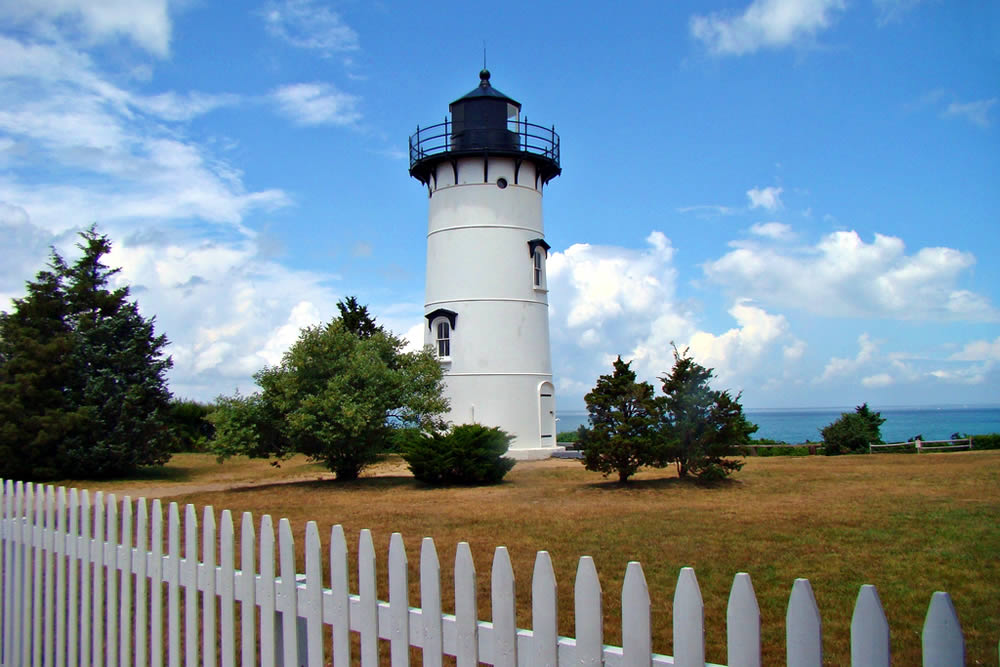Tourists flock to Martha’s Vineyard for its beaches, shopping, laid-back aura and nightlife. Some come to visit the island for its five legendary lighthouses.
According to lighthouse enthusiasts, the five lighthouses on MV hold the distinction of being the country’s most diverse group in a small contained area. All are located on the island’s north side. These historic landmarks overlook Vineyard Sound, Nantucket Sound, the entrance to Edgartown Harbor and Cape Poge.
MV’s lighthouses have a storied past. Each have earned a special place in history books for their navigational importance. At one time, Vineyard Sound and Nantucket Sound saw more ships sail through them than any other place in the world except the English Channel. 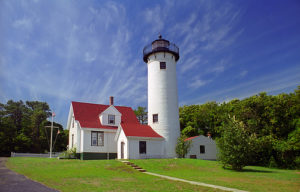
The West Chop Lighthouse in Vineyard Haven was MV’s last manned light. Built in 1817, the original wooden building was replaced by the existing brick structure in 1838. The lighthouse has been moved back from the edge of its 60-foot-high bluff twice. The first move was in 1848. The second occurred in 1891. Currently, the small caretaker’s cottage resting at its foot is home to Coast Guard personnel. Vineyard Haven’s harbor has been recognized as a port of protection since 1645.
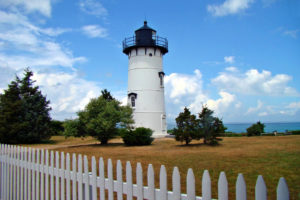
The East Chop Lighthouse in Oak Bluffs sits on one of the first telegraph signals. Set up in 1828, the signals from Nantucket were received on MV and relayed on to Woods Hole, Bonnedale, South Plymouth, Duxbury, Marshfield and Dorchester Heights. A series of raised and lowered arms and flags transported news about cargos of ships arriving at Nantucket. The U.S. government purchased the lighthouse and its land in 1875 for $6,000. The present cast-iron structure was built on the cliff 79 feet above the sea. The East Chop Light was affectionally called the Chocolate Lighthouse, for its brown-red color, until it received a heavy coat of white paint in 1988.
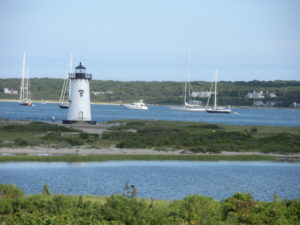 The first Edgartown Lighthouse was built in 1828, on a small man-made island in the Edgartown harbor. An Act of Congress allocated money to build it 1/4 mile from shore. For a full year, the only way to get to the lighthouse was by boat. Additional Congressional funds allowed for a foot bridge. The original structure was replaced in 1938 by one that arrived on the Vineyard via a raft from Ipswich. The new light was placed on the original site. Sand has filled in the area between the island and the mainland so that the current Edgartown Lighthouse stands on shore.
The first Edgartown Lighthouse was built in 1828, on a small man-made island in the Edgartown harbor. An Act of Congress allocated money to build it 1/4 mile from shore. For a full year, the only way to get to the lighthouse was by boat. Additional Congressional funds allowed for a foot bridge. The original structure was replaced in 1938 by one that arrived on the Vineyard via a raft from Ipswich. The new light was placed on the original site. Sand has filled in the area between the island and the mainland so that the current Edgartown Lighthouse stands on shore.
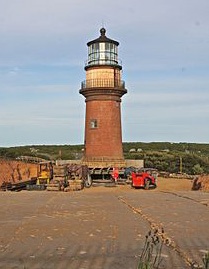
The Gay Head Lighthouse is perched perilously close to the eroding Aquinnah cliffs. The lighthouse was moved farther inland in 2016. The famed red brick lighthouse was first built in 1844 to replace a wooden tower authorized by President John Quincy Adams. In 1856, after a stellar debut at the Paris World’s Fair, the Fresnel lens with its 1,009 prisms was installed. The prism is now preserved at the Martha’s Vineyard Historical Society in Edgartown. The view from the top of this iconic lighthouse provides one of the island’s most striking scene.
The Cape Poge Lighthouse in Edgartown is the island most remote lighthouse. The original lighthouse, built in 1801, was made of wood and included a tiny caretaker’s cottage. The building was destroyed by ruining seas in 1838 and was rebuilt farther inland. It lasted a half century before 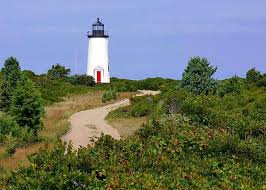 the unchallenging sea reclaimed it. It was rebuilt with a change from reflector lamps to red and white revolving prisms. Once again, in 1892, the seas destroyed the lighthouse. It was rebuilt as a 33-foot-tall tower that stood for another 35 years. Today’s white wooden structure was built in 19 22, and rests 300 feet from the challenging seas. It stands 55 feet high with a light visible for a distance of 12 miles. In 1985 it became the first entire lighthouse to be moved by helicopter. In 1997, the lantern was again moved by helicopter for repairs. The lighthouse’s present site is 300 feet from the fickle and sometimes ferocious sea.
the unchallenging sea reclaimed it. It was rebuilt with a change from reflector lamps to red and white revolving prisms. Once again, in 1892, the seas destroyed the lighthouse. It was rebuilt as a 33-foot-tall tower that stood for another 35 years. Today’s white wooden structure was built in 19 22, and rests 300 feet from the challenging seas. It stands 55 feet high with a light visible for a distance of 12 miles. In 1985 it became the first entire lighthouse to be moved by helicopter. In 1997, the lantern was again moved by helicopter for repairs. The lighthouse’s present site is 300 feet from the fickle and sometimes ferocious sea.
With the exception of Cape Pogue, all of MV lighthouses are easily accessible by road and are a must see attraction.

